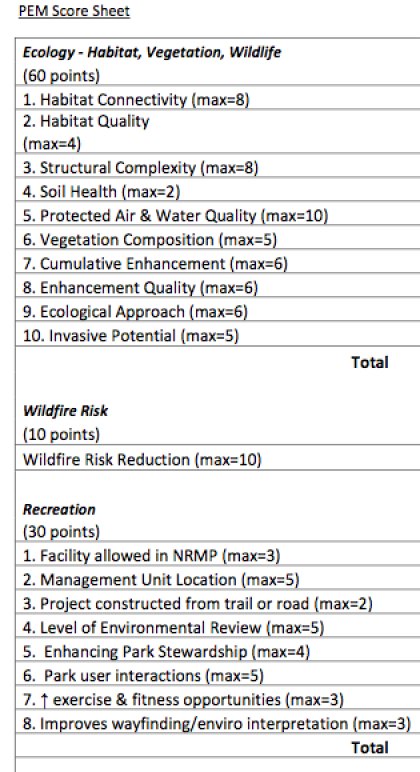
wide-reaching impact on the future of bicycle access
in Forest Park.
(Photo © J. Maus/BikePortland)
The City of Portland’s Parks & Recreation bureau recently unveiled a draft document that could act as their guide to the future of how Forest Park is used. The goal of the new Forest Park Project Evaluation Methodology (PEM) is to provide, “a systematic and consistent method to evaluate projects” in order to, “screen construction and capital projects that propose alterations to the current landscape.”
For people who care about bicycle access in the park, this is an important new document because it will help Parks staff decide if and how existing and new paths within Forest Park should accomodate bicycles. The new tool synthesizes the findings from several recent studies and surveys about Forest Park and the Parks Bureau says they plan to use it in conjunction with the existing Forest Park Natural Resource Management Plan.
At the core of the PEM tool is a scoring methodology that gives points to how projects rate on three key categories: ecology (60 points); recreation (30 points), and wildfire risk (10 points). Below is a complete breakdown of scoring:

As expected, this new PEM tool has raised the eyebrows of activists involved with the debate over bicycling in the park. And it appears both sides are concerned about it.
Marcy Houle, the dedicated Forest Park activist and author who has spent years vehemently opposing any new bicycle access in the park while lobbying local elected officials and spreading anti-bike propaganda in local papers, has already started an effort to discredit the PEM tool.
Houle wrote a letter to neighborhood groups outlining reasons why she opposes it and she’s urging others to contact Parks Commissioner Amanda Fritz with their comments. At the heart of Houle’s concerns is that the PEM tool would give Parks a way to move forward with increased bike access. “I am deeply concerned,” she wrote.
So far, we haven’t heard from the Northwest Trail Alliance about how the PEM tool might impact this ongoing debate. (UPDATE: Scroll down for comment from NWTA President Jon Pheanis.)
Frank Selker, a citizen activist who has worked to improve biking opportunities in the park, tells us he doesn’t like the PEM either. “It appears designed to create a high hurdle to any change and prevent anything from happening in the park… A wonderful project that offers great recreation and enhanced enjoyment of the public, and causes no ecological change would be rejected because it does not enhance ecology.” He says the scoring methodology in the PEM gives too much weight to ecology while giving only modest weight to user recreation. “This propagates the myth that the Natural Resources Management Plan is all about ecology, which it is not.”
He also faults the PEM for making too much of the scoring method subjective. “It gives a false impression of objectivity to what is likely to continue to be a political and neighbor-dominated issue.”
Seems like both sides of this debate have reasons to fear the PEM tool. Does that mean it might actually work? Download a copy of the draft PEM (PDF) for yourself.
Keep in mind, this is a draft tool and the City is asking for your feedback on how to make it better. If you’d like to learn more and weigh in with your thoughts, Parks will host a meeting tonight (8/5) at the Hoyt Arboretum (4000 SW Fairview Blvd) from 6:30 to 8:00 pm. If you can’t make that meeting, please send in your comments to Commissioner Fritz at amanda.fritz@portlandoregon.gov or use the online comment form. The City will be accepting comments on the PEM until August 19th.
UPDATE, 2:40 pm 8/5:
Here’s what Jon Pheanis, president of the Northwest Trail Alliance, thinks about the PEM:
“Our main question related to the draft PEM is simply whether any new trails or trail improvements would ever be possible. Clearly the primary management goal of the park is to protect and improve ecological health and wildlife habitat. But do the criteria effectively end the chance of any new or improved trails? According to the city, the majority of studies done to date all indicate that the majority of Forest Park users are white, middle-aged, from Multnomah County and have a higher average income. Why doesn’t the PEM encourage more diverse users? Part of the bureau’s mission is to provide parks for all. Not only would we like this issue addressed, but we would like to see the city proactively try to change the statistics for park use. We feel trails are one way to make this happen, but right now, not possible given the draft scoring system.
We are also disappointed that the draft does not forward any of the hard work and recommendations brought forth from the single track advisory committee; a diverse group of stakeholders who have demonstrated how divergent interests can work together and come up with some reasonable, cost-effective and publicly-supported recommendations. The PEM does not encourage collaboration, cost effectiveness or projects that serve multiple interests and goals.
Of course there are procedural questions that the draft doesn’t address, such as: can the proposer still submit a land use application? If so, what is the review process and what, if anything, can the public do if they feel their project was evaluated unfairly?
Nevertheless, we hope for a great turnout tonight with a chance to hear from all sides. As a first draft, we feel optimistic that this initial draft will serve as a catalyst for discussion for a better managed Forest Park.”

